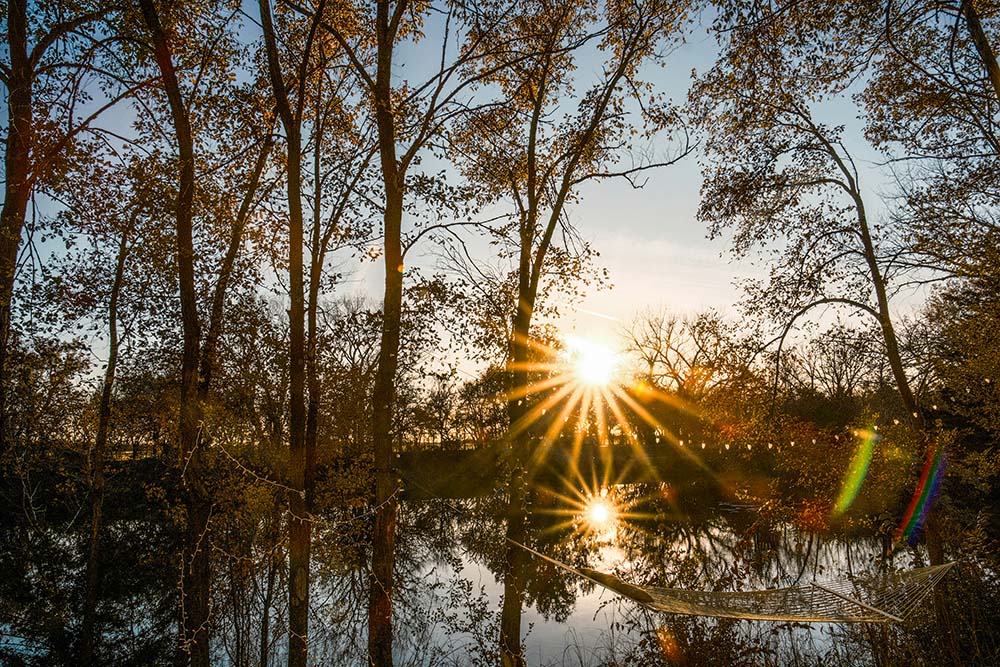
(Unsplash/Noah Ridge)
According to a recent survey of Americans, 45% of respondents find being outdoors or in nature to be the most spiritually satisfying activity. Prayer comes close, but church attendance lags far behind.
Why does nature touch us so deeply? The Bible — one long creation/love/salvation story, a saga of God's home-building project — suggests an answer that also addresses the core of Christian faith.
At the beginning of the Bible, in Genesis 1, we encounter a God busy with building a temple — creation — in which to dwell. According to William Brown in his book The Seven Pillars of Creation, the literary structure of the text mirrors the structure of Mideastern temples, including Jerusalem's. On day seven, the Sabbath, God rests and delights in the holy-of-holies, the home God has built for Godself. God dwells in the temple of creation, the work of God's hands.
The priestly authors of Genesis 1 completed their creation story in Exodus 25-40 with the building of the Tabernacle, a portable temple. There, the Spirit of God descends on the Tabernacle in the wilderness and dwells among the people (Exodus 40:34-35). Although God resides in all things, God presents Godself in a locale where the Hebrew people can more easily encounter and engage God. The Tabernacle becomes a visible manifestation of God's dwelling with God's people, as does, eventually, the Temple in Jerusalem.
Temples of Israel's neighbors often included an image of their god in the holy-of-holies to provide a tangible sense of their god's presence. Unlike their neighbors, the Hebrews resisted making images of God. The Hebrew Bible contains many passages inveighing against idols and ridiculing graven images (e.g., Exodus 34:17, Leviticus 26:1, Deuteronomy 29:17, 1 Kings 16:13, Psalm 78:58, Isaiah 31:7, Ezekiel 6:5, Zechariah 13:2).
The authors of Genesis 1 made a startling declaration when they said that God made humans in God's image. The Hebrew Bible has only five instances where something (humans) serves as God's image. Three of those instances are in Genesis 1:26-27. The other two are Genesis 5:3 and 9:6. (The Book of Wisdom contains three instances [2:23, 7:26, and 13:16] and Sirach contains one [17:3]. However, these Apocryphal books, while included in the Catholic Bible, are not part of the Hebrew canon.)
Evidently, in the authors' view, only humans possessed the ability to present God's presence tangibly to the world.
Advertisement
How would this image reveal God's presence to the rest of creation? Genesis 2 provides an answer. In this creation story, God hasn't gone to the trouble of building a temple because "God had not caused it to rain upon the earth, and there was no one to till the ground" (Genesis 2:5). God needed a gardener.
So, God made a human out of dirt and placed it in the garden to "till it and keep it." The Hebrew words used here, abad and shamar, mean "to serve," even to the point of "being a slave to" and "to watch over, keep or preserve."
Humans serve the garden, not the other way around, thereby exhibiting God's "loving-kindness" or mercy toward all, never destroying or harming creation. This is the kind of dominion Genesis 1 calls humans to exercise — one of service and self-sacrifice. This is how humans act as an image of God to the rest of the created world.
A home, a dwelling where all its inhabitants support one another and flourish, is more than a building. The Hebrew Bible relays God's attempts to mold the Hebrew nation into God's image by dwelling with them and admonishing them through the prophets. In the New Testament, God acts in a startling way to foster the relationships that would make creation a home. Through the Incarnation, God and creation interpenetrate, much like the Persons of the Trinity.
When the Gospel of John tells us that "the Word became flesh and lived [tabernacled] among us" (1:14), the word used is sarx, which means the stuff out of which all living things are made, or just "stuff" as one Bible scholar who is a friend of mine puts it — matter and energy. God the potter becomes one with the clay.
In Acts, Peter tells us the Spirit fell on all sarx at Pentecost as the prophet Joel had foretold. So, just as the Spirit of God fell on and filled the Temple of Solomon and the Tabernacle, and then fell on Jesus at his baptism, so does the Spirit fall on and fill the temple of creation. Thus, in the New Testament with the coming of Jesus and the Spirit, God both lives in the temple of creation and is the temple of creation (while remaining separate from it).

(Unsplash/Jessica Mangano)
The Epistles of Paul frequently refer to Jesus as the "Image of God" (1 Corinthians 11:7, 2 Corinthians 4:4, Colossians 1:15).
The Gospel of John also implicitly refers to Jesus as God's image when it says: "Philip said to him, 'Lord, show us the Father, and we will be satisfied.' Jesus said to him, 'Have I been with you all this time, Philip, and you still do not know me? Whoever has seen me has seen the Father' " (14:8-9). So, not only is Jesus the temple, Jesus also is the image in the temple, once again the visible manifestation of God.
So what difference does the Incarnation make? When Jesus died on the cross, not only did he come back from the dead, but he came back different. He walked through closed doors and disappeared only to reappear elsewhere. He ate and drank. Jesus came back in a new body with new abilities, ushering in the beginning of a new creation — a renewed creation that retains the features (including the scars) of the old, but brims with new life.
By undergoing death and coming back in a new body, God changes the rules of the game. God begins the saving of the world, the saving from death, predation, parasitism, suffering, illness, war, violence, environmental degradation, extinction and the myriad ways the current home fails to reflect a totally loving and self-giving God.
While salvation includes our gaining eternal life, it encompasses far more than individuals "going over Jordan" as many many spirituals and gospel songs proclaim. The end game includes all things being swept up into new life. Jesus didn't go through death just so you and I could go to heaven — God endured death to save everything from the cycles of death that bind us.
Through Jesus' life and death, eternal life begins now in a Spirit-led relationship with God so that we might "have life and have it abundantly " today (John 10:10).
This promise of eternal life has cosmic implications: The coming kingdom of God has started. The new creation has begun. The Spirit flows among Jesus' followers to draw them into a loving unity that more closely mirrors the unity of the Trinity so that Jesus, the quintessential image of God, might be imaged in his followers.
Thus, Christ's followers become the body of Christ. Given, however, that the Spirit fell on all creation, we similarly may think of the Spirit weaving all creation into God's body.
At the end of time, as Ephesians 1:8-10 and the Book of Revelation tell us, God "will gather up all things in him, things in heaven and things on earth." Heaven will come down to Earth — we won't go up to heaven. Instead, heaven and Earth will merge.
In this New Jerusalem there will be no temple nor sun because God will be the temple and God's light will illuminate everything. All things now will live in God and see God face to face.
In a time when we face innumerable human and environmental crises, let us remember that God is enlisting us in a project to build our common home, one where all things will prosper in harmony, one where we easily encounter God. The Resurrection tells us we can have hope in the midst of darkness if we allow God's Spirit to guide us.








